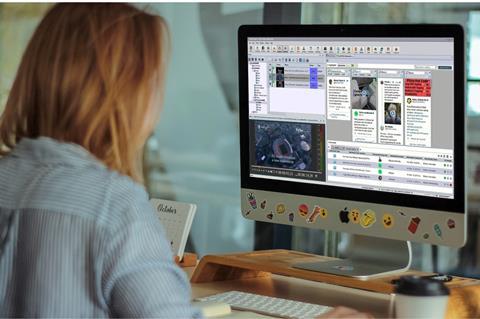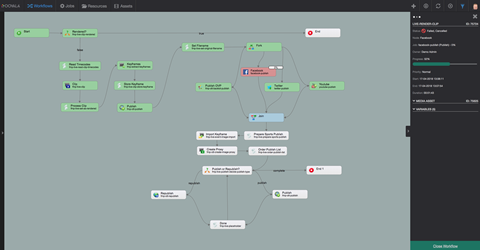Automation is certain to play an ever-greater role as broadcasters work to service more platforms with more content than ever before, writes David Davies.

The extent to which multi-platform, multi-device viewing will ultimately transform our daily lives is still yet to become fully clear. But what has already become evident is the impact that it is having on broadcasters, who are now having to cope with the challenge of providing dramatically increased volumes of content to more platforms.
“Today’s audiences want their content wherever they are and on the platform of their choice,” says Neil Maycock, SVP strategic marketing & playout at Grass Valley.
“This is probably most evident in news production, which now entails live and on-demand content development and delivery for mobiles and tablets among other devices, as well as on social media platforms such as Facebook, Twitter, Periscope and YouTube. The challenge for broadcasters is to not only meet consumers’ expectations so their news product remains competitive and relevant but to do this in a commercially viable way.”
For most content creators, the current strategy tends to involve the optimisation of existing workflows, as well as making use of increased automation, especially with regard to quality checking, indexing and search functions.
‘Agility and consolidation’
Maycock indicates that there are two primary ways in which vendors like Grass Valley can help broadcasters in the multi-platform era: agility and workflow consolidation.

In the case of the former, “the lifecycle of OTT services is far shorter and more likely to change that traditional media services. We’re focused on providing agile solutions that dramatically reduce time to market for our customers, but that also allow services to adapt and scale to meet changing viewer and commercial needs.”
In terms of workflow consolidation, the primary objective is to remove duplication from delivery and distribution as much as possible. “In far too many cases there are high levels of duplication between linear broadcast workflows and OTT workflows. At Grass Valley we’re working with our customers to unify processes and workflows between the two types of content delivery; this has the highest potential for increasing efficiency.”
Examples of optimising solutions to meet OTT requirements in the Grass Valley range include the implementation within its playout solutions of the ability for output to be originated both in SDI and native streaming formats – eliminating the need for separate encoding for OTT. Meanwhile, in the Stratus production and media management solution, the company has introduced automated workflows to edit, brand and publish content to different platforms: “This not only reduces the labour overheads – it also dramatically reduces the overtime to get content to air/online.”
Consistency of user experience
The main concerns of broadcasters servicing multiple platforms are listed by Imagine Communications VP product management Mark Senecal as “delivering the same quality of service to all platforms, including aspects such as frame accuracy, and providing the same quality user experience in branding while also tailoring the experience to each platform – without increasing the operational complexity of running their channels.”
Broadcasters have also had to rethink the management of some operational workflows, for example, to allow more time to drive downstream devices for OTT streams.
As with so many aspects of broadcast these days, allowing data access to drive workflows is proving to be a crucial enabler.

“Increasing the analysis done during the presales process helps better determine what platforms our customers will be driving in addition to their linear streams, and confirming the specific requirements for each platform,” says Senecal. “The linear feeds often contain the metadata other platforms require to make smart decisions; our job is to ensure that those platforms get access to this data efficiently.”
The Versio media workflow platform has been subject to a number of developments intended to aid multiplatform delivery. These include capabilities such as alternate branded outputs, uncompressed and compressed outputs, and enhanced SCTE-35/104 triggers to support downstream insertion for OTT delivery – all under singular channel control.
Senecal adds: “Our content management system provides access to metadata, and our SeleniFlex File transcoder can conform and package assets to formats required on additional platforms for VOD.”
Workflow assessment
As well as “workflow orchestration” that involves checkpoints to be set on either an automatic or manual basis, Dalet director product marketing Bea Alonso highlights the critical nature of testing before new services go live. “In our case, we always provide a staging environment so that our clients can set up and test their configurations before going live,” she says.

“This allows them to test different approaches with confidence and dry-run new launches in advance, as well as having a backup of their settings.”
Recent Dalet developments geared towards multi-platform delivery include Dalet StoreFront, which allows content creators to automate the process of safely exposing their content catalogues to licensees and partners.
“With an intuitive user interface, it eliminates the manual hassle involved in requesting and delivering content to syndication partners,” says Alonso.
Also recently launched is Dalet OnePlay, described as a fully integrated production and delivery solution for TV, radio, web and social. Having added the Ooyala Flex Media Platform business to its portfolio in 2019, Dalet is also enhancing the Flex Media ecosystem “to increase the quantity and quality of possible distribution endpoints. For instance, we have added functionality to the Brightcove Publish plug-in and improved support for MPEG-DASH.”

Additionally, Alonso teases a new project focused on news ahead of planned previews at the NAB Show in April: “Newsrooms are rapidly evolving to meet the needs of new consumption habits, and so Dalet is looking to provide solutions to help our clients ease through this transition. More to come at NAB!”
Automation expectation
There is universal agreement that AI and machine learning will become increasingly integral to delivering content across platforms. It is already the case, says Maycock, that automation is “bringing new levels of sophistication to the indexing and searching of content. The task of cataloguing archives used to be a very manual and slow process, so often cost-prohibitive. The fact that aspects of this can now be automated, such as speech and face recognition, will open up access to far more historic content.”
Senecal envisages AI being used “for QC and automatic scene detection, helping operators to handle more assets. Customer uptake of this is likely to grow over the next several years. Using AI to make more on-air decisions is some ways off, I think, but there is likely a future for it [among] lower-tier channels where there is a need to reduce the management costs of the channels.”
Alonso highlights AI’s potential role in local distribution. “When it comes to localising distribution to meet the demands of global audiences, we have observed up to 80% time savings in AI-driven subtitled creation,” she says. “Additionally, content recommendations based on AI-indexed topics, characters, relational tags and emotions can help creative teams curate attractive offerings and VOD packages to augment viewer engagement.”
Suffice to say that AI is likely to shape content delivery in ways that we haven’t even conceived of yet. Last word to Maycock: “As impressive as current AI applications are, we are almost certainly only scratching the surface of what’s possible. It’s going to be a very interesting space to watch.”
- Watch: Tech Expert: Inside AI
























No comments yet